5 Best National Parks to See Grizzly Bears in the USA
An apex predator—lonely at the top of the food chain—grizzly bears once roamed the entire western part of the North American continent, including areas on the Great Plains and as far south as northern Mexico.
Nowadays, however, after gradual elimination due to expanding human settlement, the range of these majestic animals is much smaller.
In this post, I’ll focus on the five national parks that offer the best grizzly bear viewing opportunities, whether that’s because of accessibility or exceptionally high concentrations of grizzly bears. All those parks are in the northern Rocky Mountains or southern Alaska.
First of all, let’s get a common question/misunderstanding out of the way. What’s the difference between brown bears and grizzly bears?
Brown Bears or Grizzly Bears?

This best national parks to see grizzly bears post contains affiliate links. You can read more about our Terms of Use / Disclosure here.
Simply put, the grizzly bear (Ursus arctos horribilis) is a North American subspecies of the brown bear (Ursus arctos).
Brown bears are found in much of northern North America and Eurasia, from Scandinavia, Eastern and Southern Europe, Russia and Japan to Alaska, Canada and the northern continental United States.
In North America, brown bears are often called grizzly bears, but that’s not always correct. There are some distinctions to be made.
The bears of coastal Alaska are brown bears—not grizzlies. Grizzly bears are generally considered to be brown bears that live inland, without access to coastal food sources like salmon.
Brown bears that live in coastal Alaska, in parks like Katmai and Glacier Bay for example, are actual brown bears. Brown bears found in inland parks, such as Glacier and Yellowstone but also Denali, are grizzly bears.
(Besides grizzly bears, there are also many other brown bear subspecies, such as the huge Kodiak bear, the Eurasian brown bear, Iberian brown bear and Ussuri brown bear.)
So to summarize:
- Brown bears – The species, found in the United States in coastal Alaska, with access to marine food sources. Bigger and typically less aggressive.
- Grizzly bears – A subspecies of the brown bear, found in inland regions in the United States, no access to marine food sources. Smaller than coastal brown bears and generally more reactive to humans.
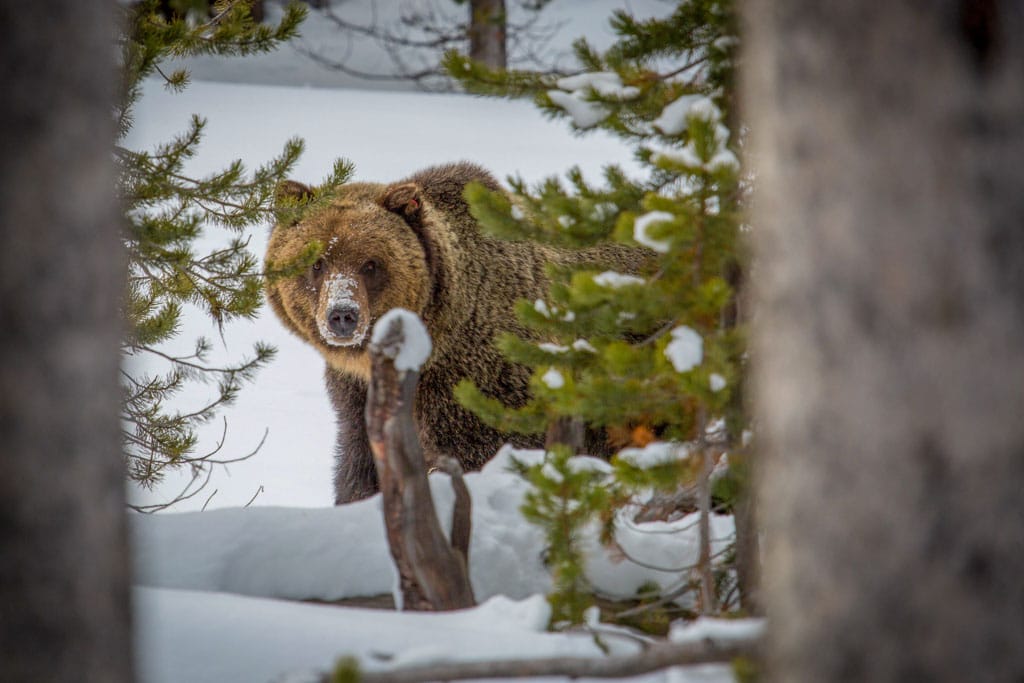
5 Best National Parks to See Brown or Grizzly Bears in the USA
While they do still occupy much of their original habitat in Alaska and western Canada, grizzly bears live in only a few areas in the contiguous U.S. (the lower 48 states).
Much of the grizzly bear habitat in the continental United States is now within national park boundaries.
You can see grizzly bears in several states in the American Northwest, from Wyoming and Montana to Idaho and even northern Washington. All those states are home to one or more national parks where you can see grizzly bears—with some patience and, often, luck.
To the northwest, Alaska’s brown bear population is healthy and spread out across basically the whole state. You can find brown bears in all seven national parks in Alaska.
So, if you’re wondering where to see grizzly bears in the U.S., your chances are highest in either the northern Rockies or southern Alaska.
The following five U.S. national parks offer the best brown or grizzly bear watching opportunities.
Yellowstone National Park, Wyoming, Montana and Idaho
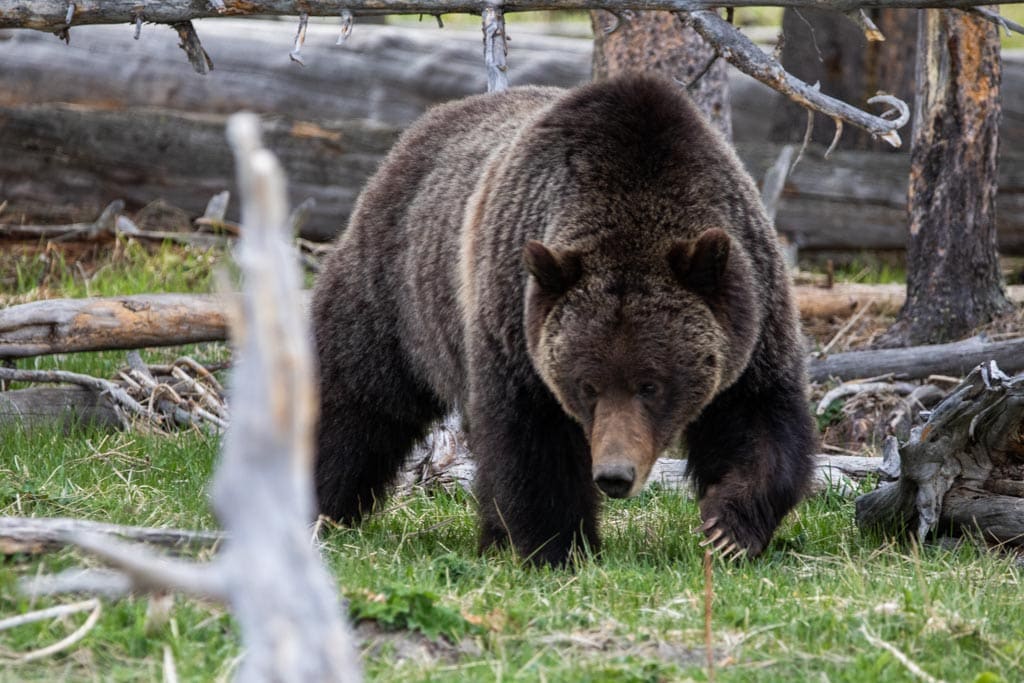
A wildlife paradise in the heart of North America, wildlife watching in Yellowstone National Park is unparalleled. This huge park—the first national park in the world—is the best place to see megafauna in the U.S.
Home to huge numbers of resident and migratory birds, as well as the largest concentration of mammals anywhere in the lower 48 states, Yellowstone is a wildlife viewer’s dream.
The park’s famous for its predator-prey relationships between large mammals in national parks.
These include eight ungulate species—white-tailed deer, pronghorn, mule deer, mountain goats, moose, elk, bighorn sheep and bison—and no fewer than seven large carnivores—coyotes, wolverines, wolves, Canada lynx, mountain lions, black bears and grizzly bears.
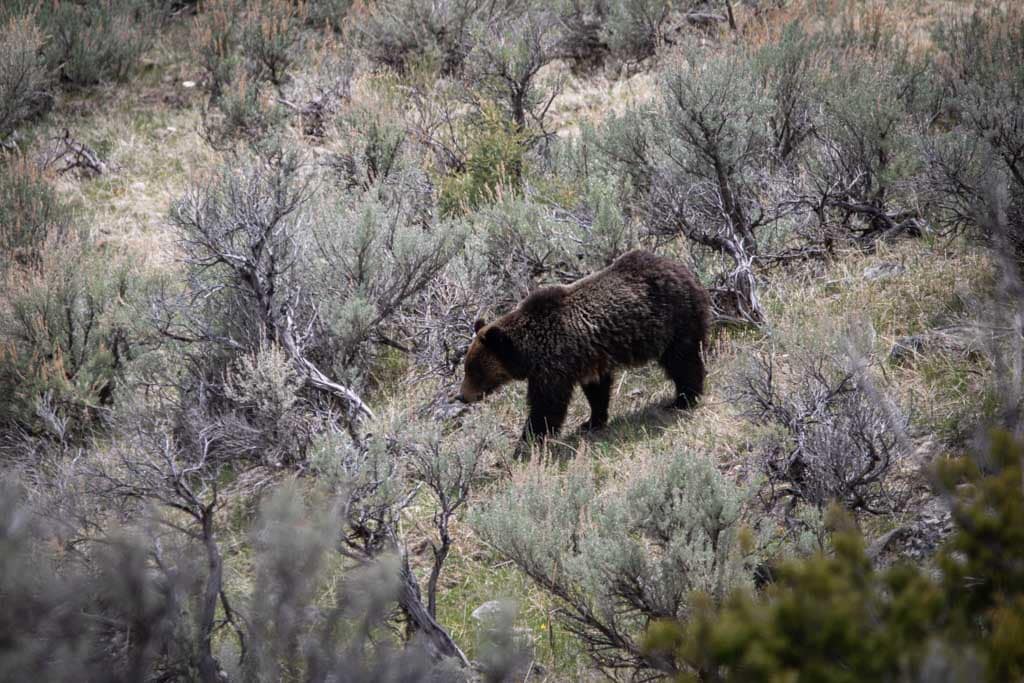
The Greater Yellowstone Ecosystem is arguably the most important refuge of grizzly bears in the contiguous United States, a region home to vast undeveloped wilderness areas and plenty of food sources.
The Yellowstone National Park grizzly bear population consists of approximately 150 individual grizzlies. In the Greater Yellowstone Ecosystem, which encompasses both Wyoming national parks (Yellowstone and Grand Teton), the total number of grizzly bears is estimated to be around 700.
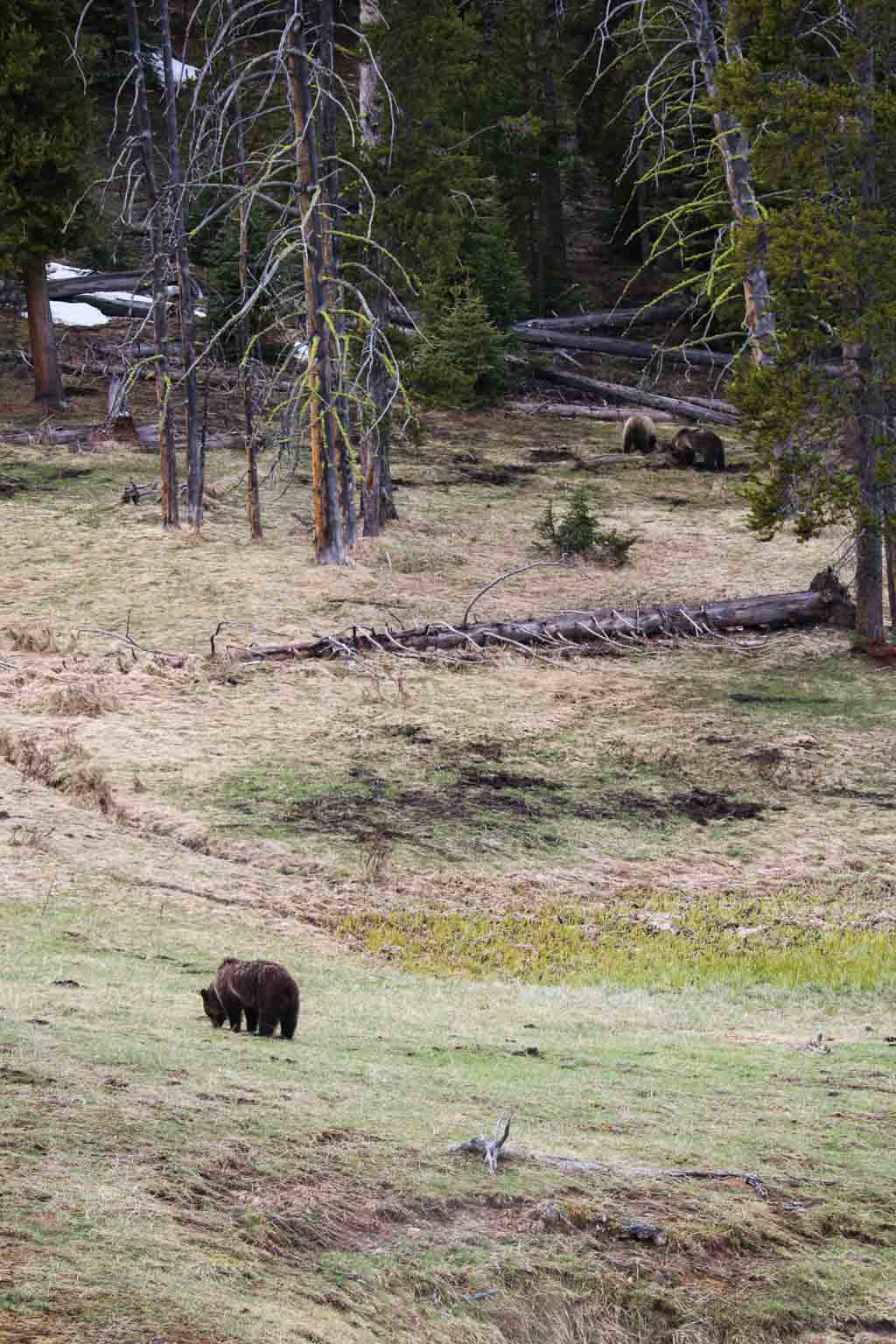
Where to See Grizzly Bears in Yellowstone National Park
- Hayden Valley
- Lamar Valley
- Around Yellowstone Lake
- Meadows between Tower-Roosevelt and Canyon
- Swan Lake Flats
- Fishing Bridge to East Entrance
- North slope of Mount Washburn
Read more about where to see bears in Yellowstone National Park here!
More About Yellowstone National Park
- Park Website
- Travel Guide
- Topographic Map
- Top Places to Visit in Yellowstone National Park
- Best Things to Do at Mammoth Hot Springs (Yellowstone)
- Scenic Spring Hikes in Yellowstone
- Accommodation
Grand Teton National Park, Wyoming
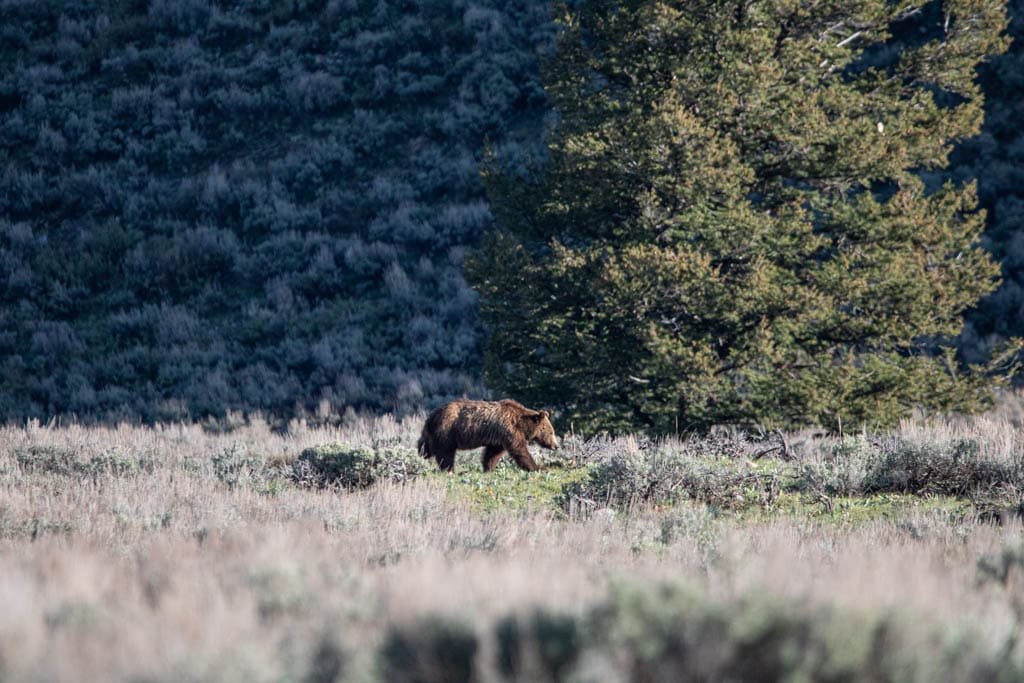
Located just south of and connected to Yellowstone by the scenic John D. Rockefeller Memorial Parkway, Grand Teton National Park is also part of the Greater Yellowstone Ecosystem.
You’ll find basically the same animals in Grand Teton as in Yellowstone, including moose, elk, American bison, black bears and grizzly bears.
The towering mountains, wide and fertile valleys, patches of woodland and shimmering lakes are prime bear habitat. And many popular hiking trails in Grand Teton National Park run right through it.
This means that you’ll have a good chance of seeing a grizzly bear in this spectacular park.
Grizzly bears migrate in and out of the park all the time, so there’s no official number of grizzlies in Grand Teton National Park. There’s always a few of them around, though!
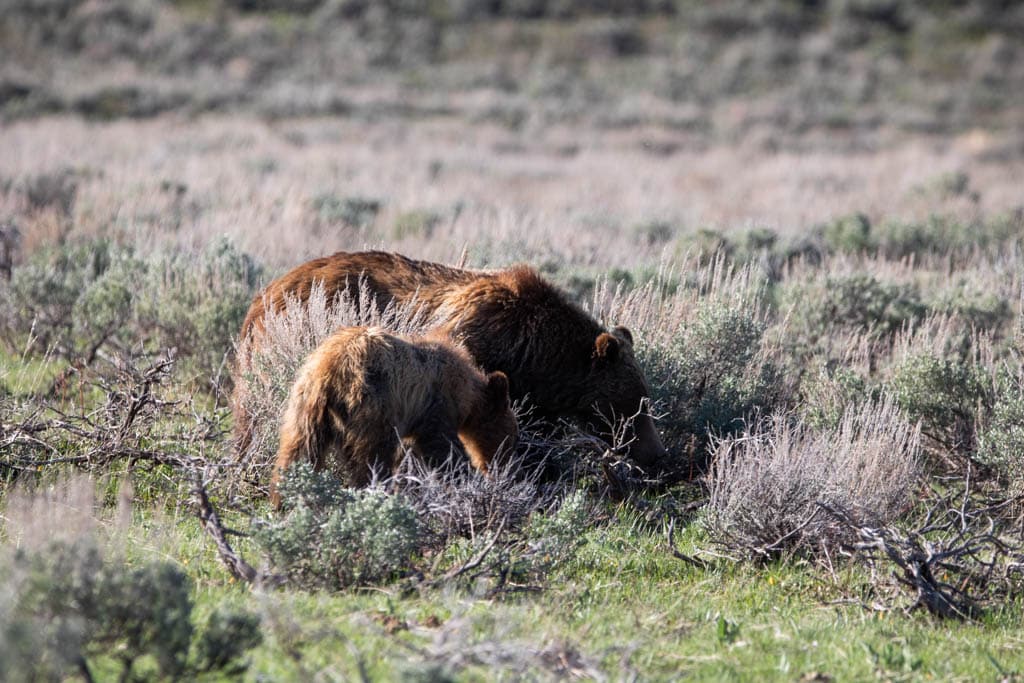
Where to See Grizzly Bears in Grand Teton National Park
- Willow Flats
- Two Ocean and Emma Mathilda Lakes
- Teton Park Road
- Moose-Wilson Road
- Jenny Lake
- Cascade and Death Canyons
Read more about where to see bears in Grand Teton National Park here!
More About Grand Teton National Park
- Park Website
- Travel Guide
- Topographic Map
- Best Grand Teton Hikes
- Top Things To Do in Grand Teton National Park
- Best Views of the Teton Range
- Names of the Teton Mountains (With Photos)
- Accommodation
Glacier National Park, Montana
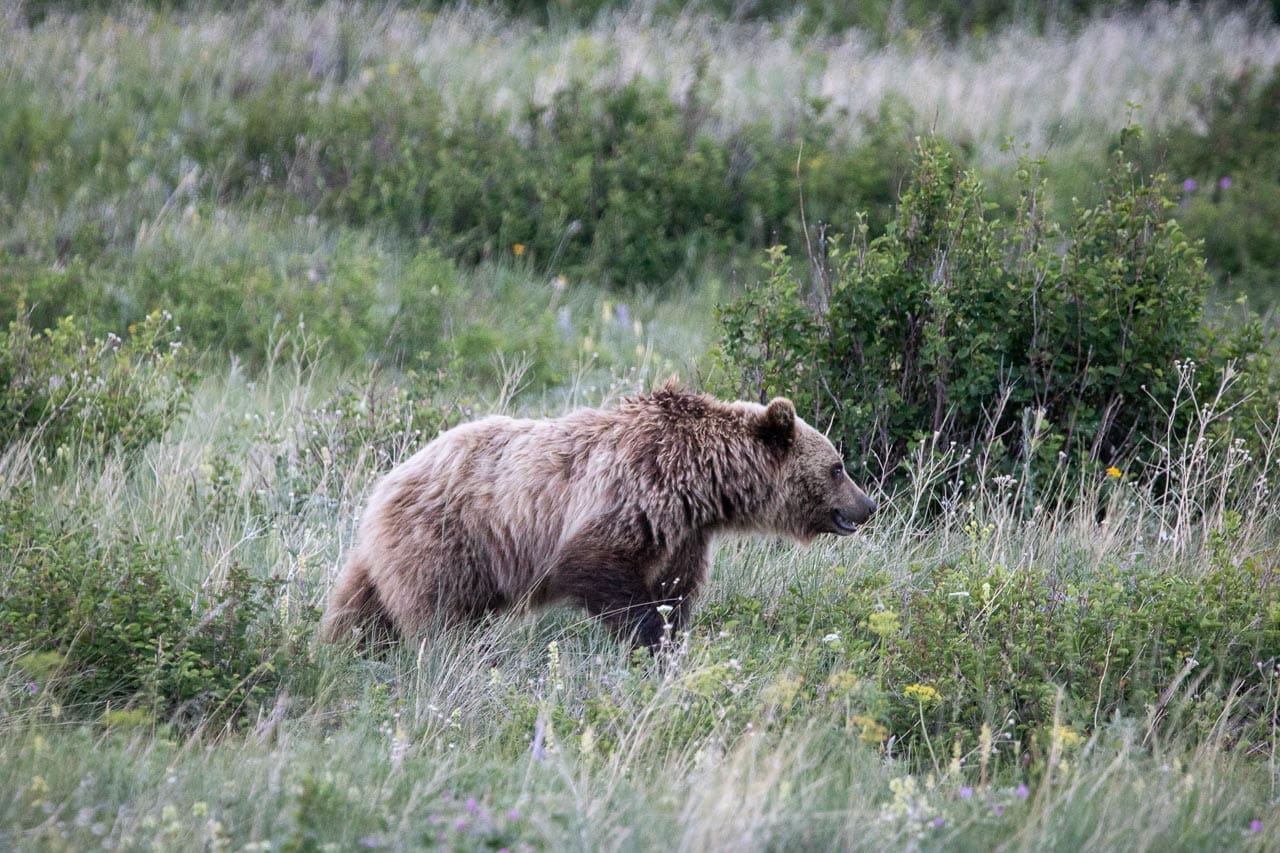
Together with its Canadian neighbor Waterton Lakes National Park, Glacier National Park makes up the UNESCO World Heritage-listed Glacier-Waterton Lakes International Peace Park. Both parks are home to a healthy and sizable population of grizzly bears, as well as numerous other animals.
Glacier National Park’s “Crown of the Continent” mountain ranges, deep glacier-carved valleys, expansive alpine meadows, forests, waterfalls and rivers form the perfect grizzly bear biome.
It’s not uncommon to see bears—both black and grizzly bears—while hiking one of Glacier’s spectacular trails or even when driving the magnificent Going-to-the-Sun Road.
Read this blog post for the best places to see wildlife in Glacier National Park.
While Glacier has had its share of issues with grizzly bears, most notably the infamous “Night of the Grizzlies”, which forever changed national park wildlife policies all over America, incidents are actually very rare nowadays.
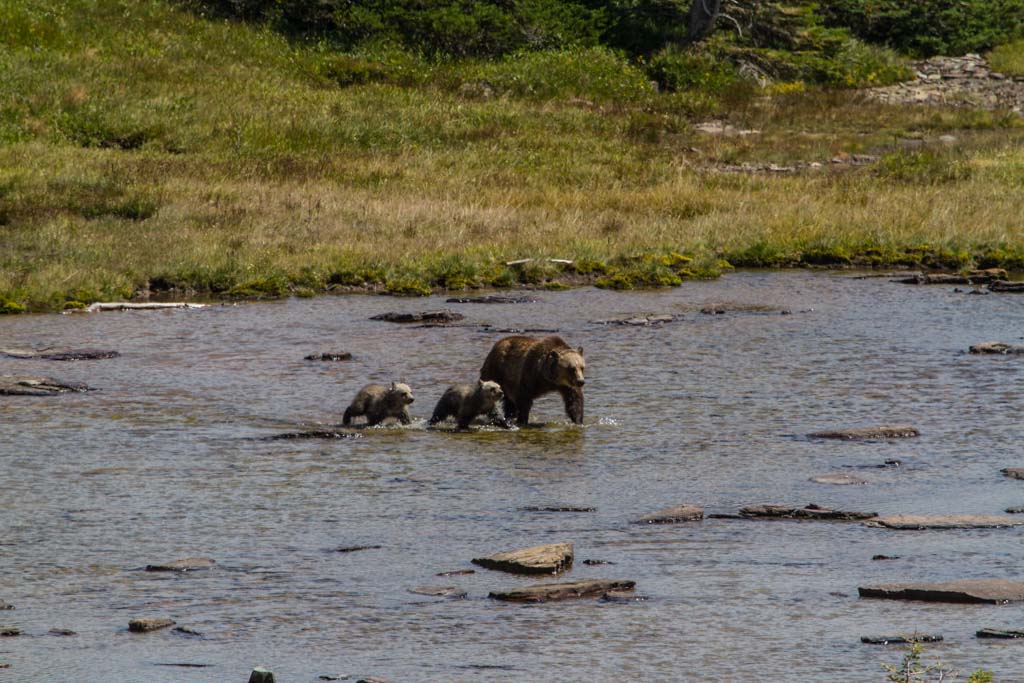
DNA sampling studies in the Crown of the Continent Ecosystem, which encompasses both Glacier and Waterton Lakes National Parks, have put the number of grizzly bears in the region at around 300.
So, this indicates that the number of Glacier National Park grizzly bears could be up to 200 at any time.
This high number of grizzlies, combined with the park’s accessibility, is why Glacier National Park is one of the best national parks to see grizzly bears in the USA.
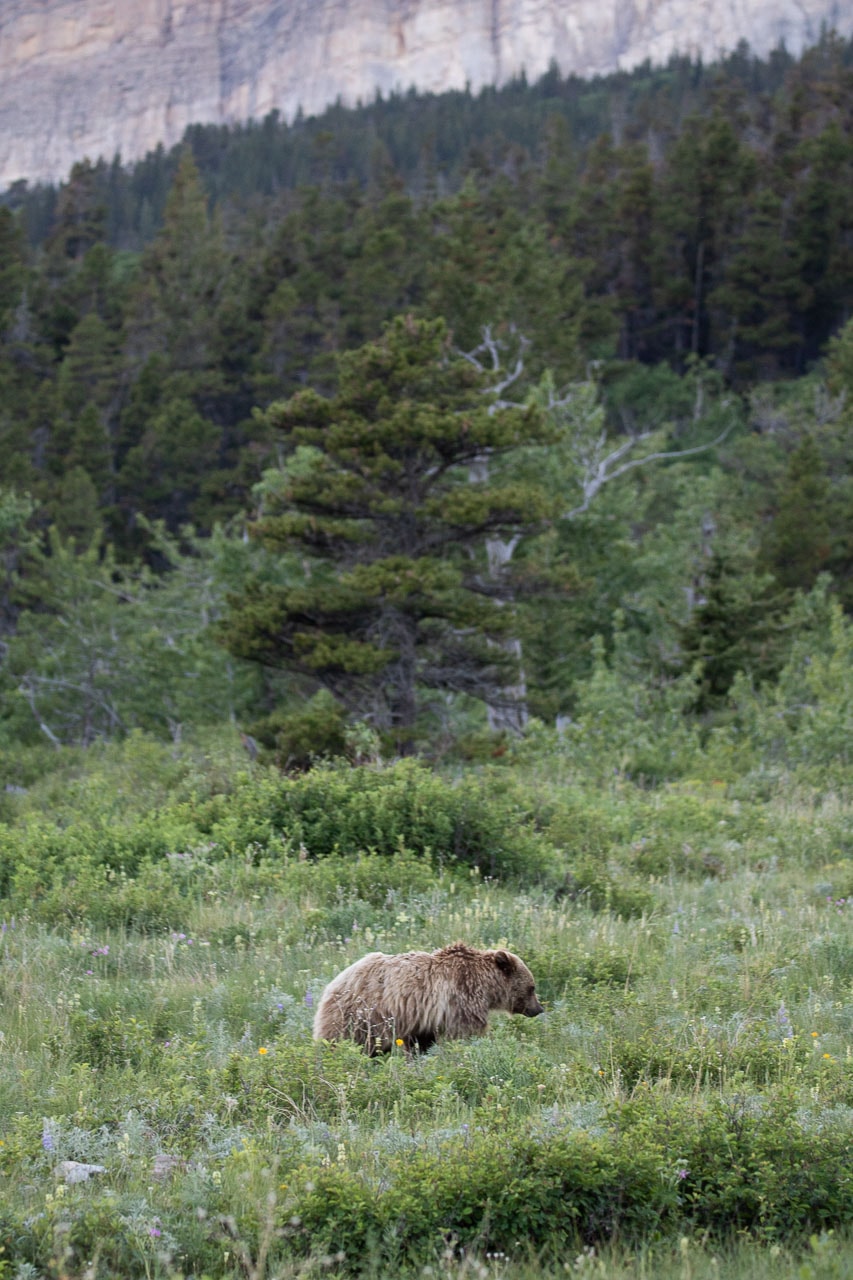
Where to See Grizzly Bears in Glacier National Park
- Logan Pass Area
- Many Glacier (Swiftcurrent Valley and Grinnell Valley)
- Two Medicine
- St. Mary Lake
More About Glacier National Park
- Park Website
- Travel Guide
- Topographic Map
- Best Glacier Hikes
- Top Attractions on Going-to-the-Sun Road
- Accommodation
Katmai National Park, Alaska
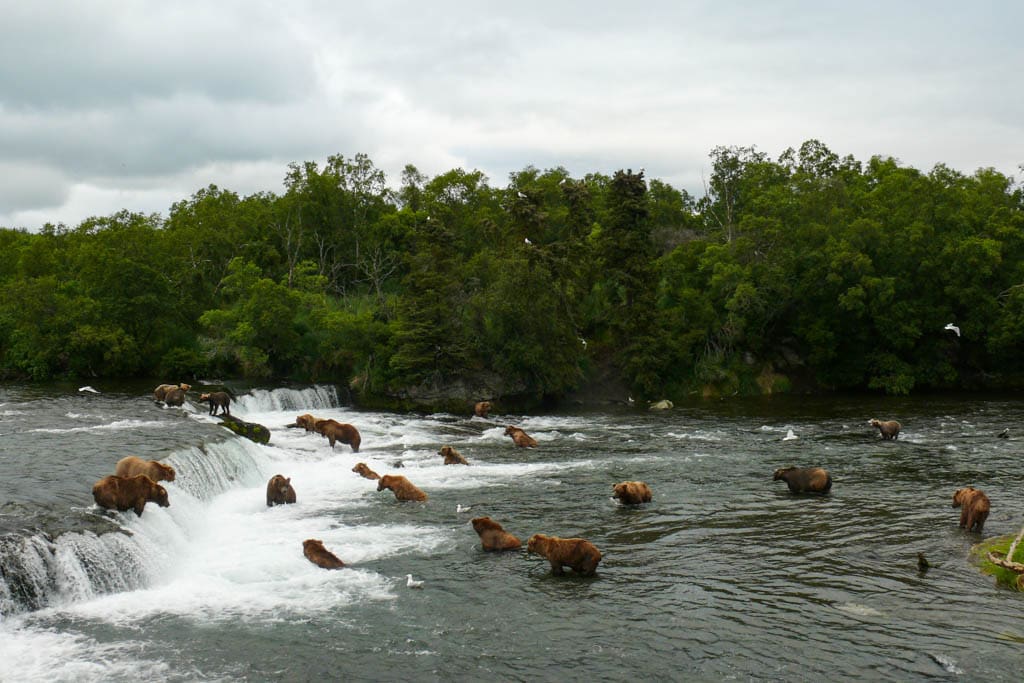
One of the most famous bear viewing locations in the world, southern Alaska’s Katmai National Park is home to huge concentrations of these ursine giants.
Accessible only by boat or aircraft, the park’s home to no fewer than 2,200 brown bears, which makes for some of the world’s highest seasonal brown bear densities.
As I explained above, those bears in Katmai National Park are brown bears—not grizzlies.
During the sockeye salmon runs of July and September, a large number of brown bears congregate along the Brooks River. This is the prime brown bear viewing season in Katmai, with Brooks Camp being the basecamp of bear watchers.
This is basically the only place in Katmai National Park that’s accessible to the average visitor. It’s reachable by small float plane from numerous villages and towns in the region, including Anchorage, Homer, King Salmon and Kodiak.

In July, you’ll find dozens of brown bears at photogenic Brooks Falls, while in September, most bears are at the mouth of the Brooks River.
It’s important to note that these bear gatherings coincidence with the July and September salmon runs. There are very few bears at Brooks Camp in June or August. So, plan you visit accordingly!
Interestingly, even though there’s a huge Katmai National Park brown bear population, there are essentially no black bears in the park. In the entire history of the park, there’s been just one verified black bear sighting.
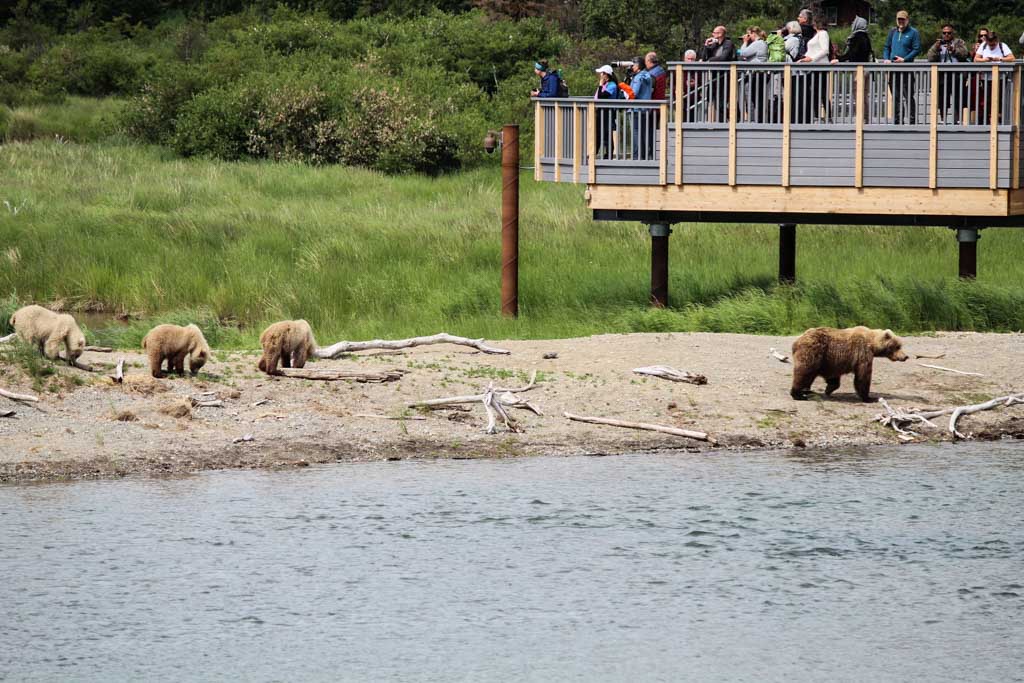
Where to See Brown Bears in Katmai National Park
- Brooks Falls
- Hallo Bay
- Geographic Harbor
- Moraine Creek and Funnel Creek
More About Katmai National Park
Denali National Park, Alaska
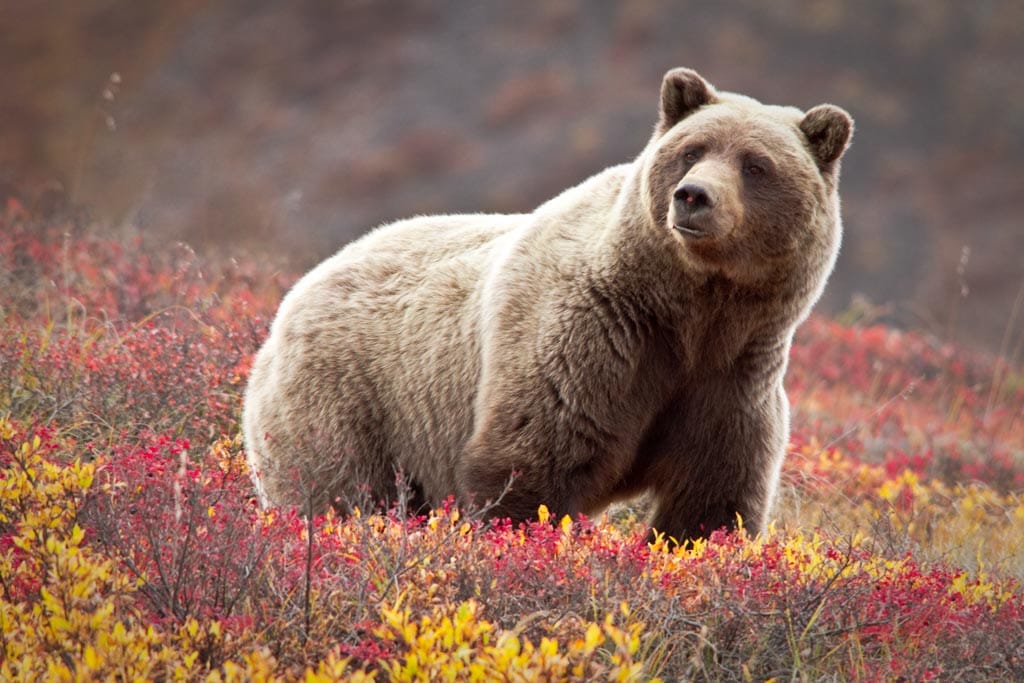
One of the top parks for wildlife viewing in Alaska, Denali National Park was established in 1917 specifically to protect the Alaska Range’s wildlife.
Both black bears and grizzly bears live in the park, but unlike many other parks, you’re more likely to see a grizzly than a black bear.
The Denali Park Road is the only road through the park, so unless you’re backpacking, that’s where you’ll be doing your grizzly bear watching.
Note that the Park Road is closed to private vehicles beyond Mile 14. The rest is accessible with the convenient hop-on hop-off Denali Park Transit Buses.
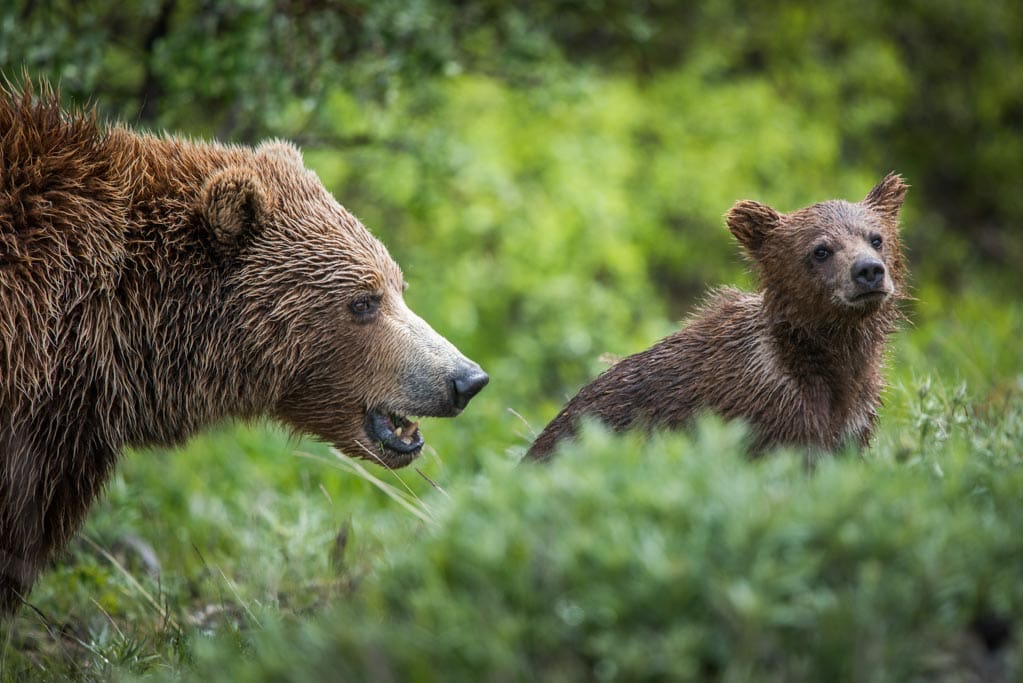
Grizzlies can be found all over Denali National Park, from its valleys and riverbanks to the higher slopes and mountain passes.
Additionally, since the Denali National Park grizzly bears aren’t focused on salmon runs, you can see them any time the Park Road is open. That’s usually from early-June through mid-September.
This abundance and distribution of bears is why Denali National Parks is one of the best national parks to see grizzly bears in America.

Where to See Grizzly Bears in Denali National Park
- Sable Pass
- Teklanika River
- Toklat River
- Savage River
- Highway Pass
- Thoroughfare Pass
More About Denali National Park
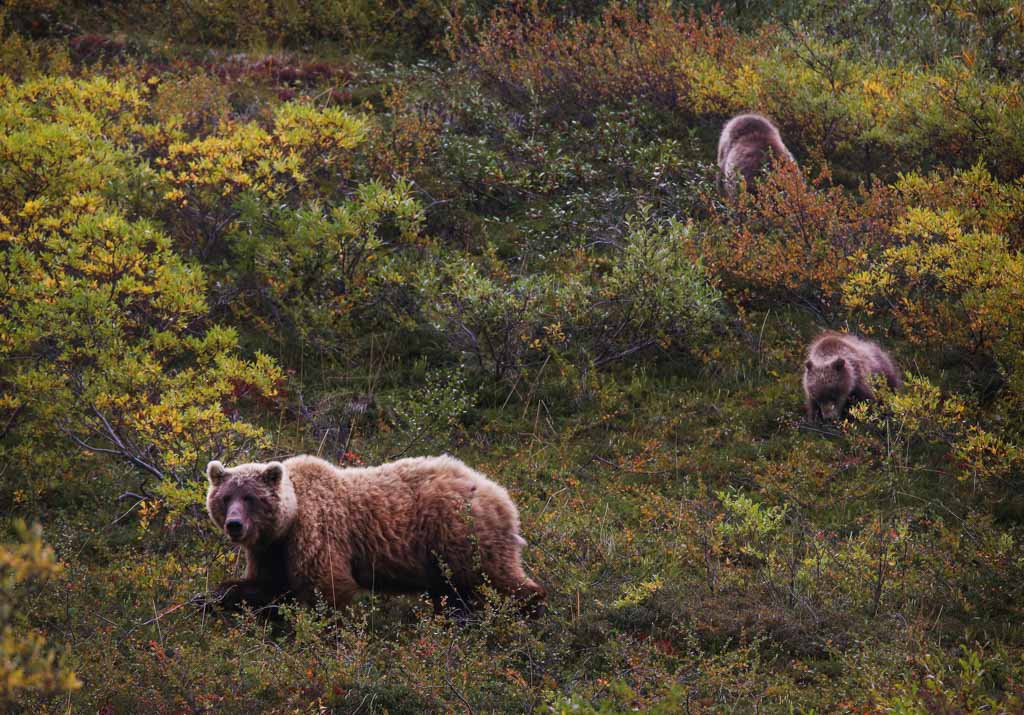
Other U.S. National Parks With Brown or Grizzly Bears
In addition to the five featured parks above, which are the best national parks to see grizzly bears, there are several other national parks with grizzly bears in the U.S.
Only one of them, however, is in the lower 48 states. The North Cascades grizzly bear population consists of only a few individuals, which are basically never seen by casual visitors.
All other parks are in Alaska and either offer only sporadic brown or grizzly bear sightings or are quite difficult to get to for the average traveler.
- North Cascades National Park, Washington
- Glacier Bay National Park, Alaska
- Kenai Fjords National Park, Alaska
- Lake Clark National Park, Alaska
- Gates of the Arctic National Park, Alaska
- Kobuk Valley National Park, Alaska
Grizzly Bear Books I’ve Read and Recommend
- Down From the Mountain: The Life and Death of a Grizzly Bear – Bryce Andrews
- The Twenty-Ninth Day: Surviving a Grizzly Attack in the Canadian Tundra – Alex Messenger
- Taken by Bear in Yellowstone: A Century of Harrowing Encounters between Grizzlies and Humans – Kathleen Snow
Staying Safe in Grizzly Bear Country
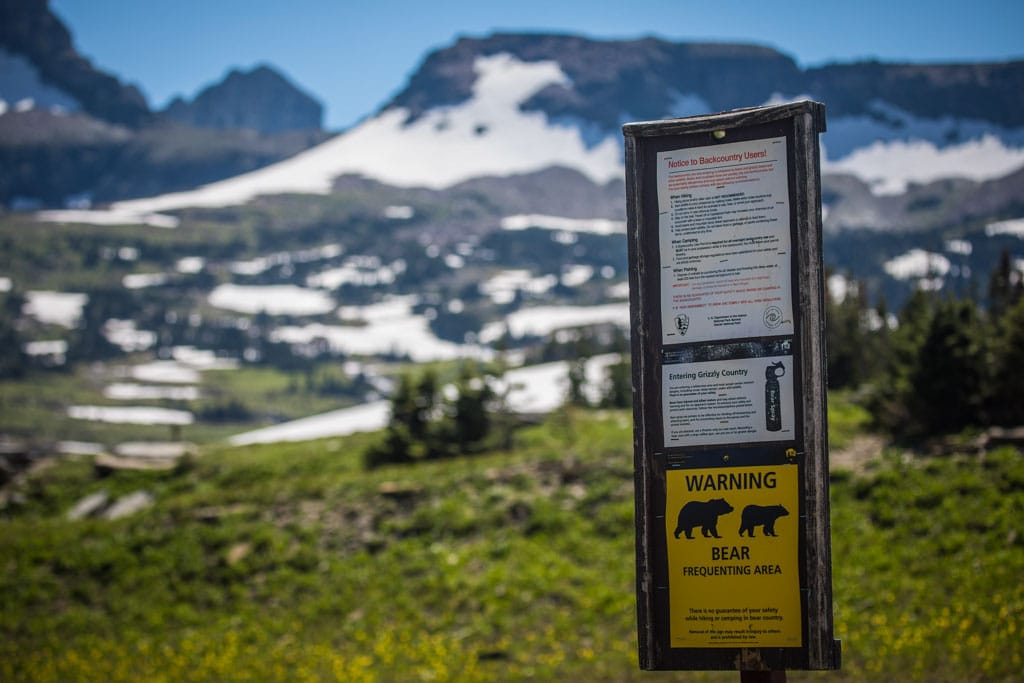
One of the largest predators in the world, grizzly bears are imposing, beautiful, majestic, fascinating and terrifying all at the same time. For many people, seeing a grizzly bear in the wild is an experience they’ll remember for the rest of their life.
For some people, however, a grizzly bear encounter has entirely different consequences.
Although grizzly bear attacks are very rare, especially considering the huge number of people who visit the national parks with grizzly bears above, they do occasionally happen.
To limit the risk of running into a grizzly bear, and to increase your chances of survival in case of a grizzly attack, there are several things you can—and should—do.
I’ve outlined all of them in this grizzly safety blog post.
In all national parks with grizzly bears, you must keep a minimum distance of 100 yards from bears and wolves, and at least 25 yards from all other wildlife. Getting any closer is prohibited!
Binoculars
To properly see grizzly bears (and other wild animals for that matter) from a safe distance, a good pair of binoculars is an unmissable tool.
Bear Spray
The most effective way to deter an aggressive and/or defensive grizzly bear, bear spray is arguably the most important thing to take with you into bear country. Learn how to use bear spray correctly here.
Have You Ever Seen Grizzly Bears in the Wild in a National Park? Share Your National Parks Experience in the Comments Below!
More National Parks for Wildlife Watching
- Best National Parks to See Bison
- Best National Parks to See Wolves
- Best National Parks to See Black Bears
- See Native Mountain Goats in These National Parks
- Best National Parks to See Orcas
- Best National Parks to See Moose
- Shenandoah National Park Wildlife Viewing Guide
- Best National Parks for Bird Watching



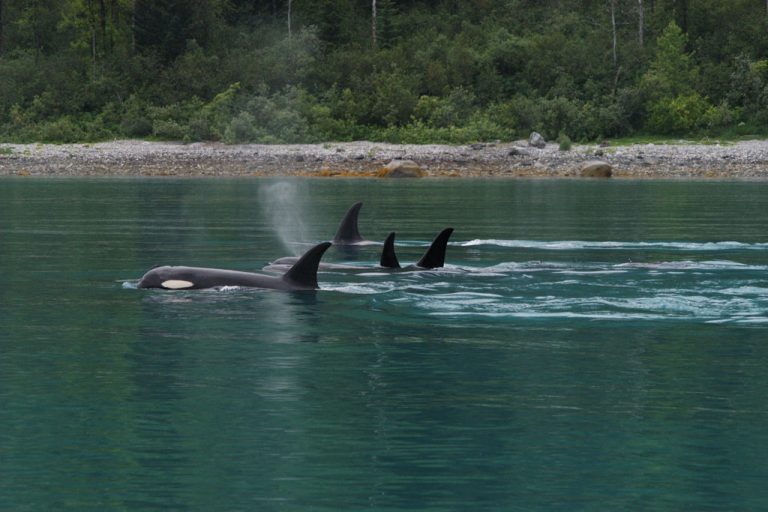

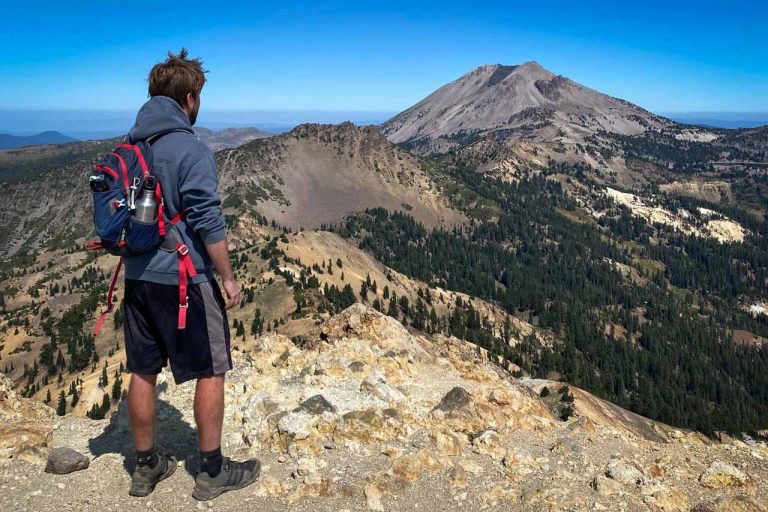

I have had my greatest success in both sightings, and photography of grizzly bears in Glacier National Park. You can find photos of these great bears on my Facebook page. I used to work in Glacier and made 7 return trips there. I wrote a song about the grizzly called “The Glowing-robed King” and, on calendars, greeting cards, award certificates, and books I have composed, I have a photo of a grizzly I photographed on Glacier’s North Fork Road on the publication emblem “Grizwold Grizzly Publications.” In case you haven’t noticed, the grizzly is my favorite animal!
It does seem like grizzlies are very close to your heart, Les. They are amazing and beautiful animals! I’ve had the great fortune to see grizzly bears in Glacier, Yellowstone and Grand Teton, often more than once, which was a major highlight of each park visit. I am absolutely fascinated by them as well and have read numerous books about them, too. Thanks for your comment!